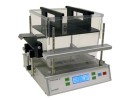Authors
C. Tiraby, G. Tavernier, F. Capel, A. Mairal, F. Crampes et al.
Lab
Institut de Médecine Moléculaire de Rangueil, Laboratoire de recherches sur les obésités, Toulouse, France.
Journal
Diabetologia
Abstract
Aims/hypothesis: Uncoupling protein (UCP) 3 is a mitochondrial inner membrane protein expressed predominantly in glycolytic skeletal muscles. Its role in vivo remains poorly understood. The aim of the present work was to produce a mouse model with moderate overproduction and proper fibre-type distribution of UCP3. Methods : Transgenic mice were created with a 16 kb region encompassing the human UCP3 gene. Mitochondrial uncoupling was investigated on permeabilised muscle fibres. Changes in body weight, adiposity and glucose or insulin tolerance were assessed in mice fed chow and high-fat diets. Indirect calorimetry was used to determine whole-body energy expenditure and substrate utilisation. Results: Transgenic mice showed a twofold increase in UCP3 protein levels specifically in glycolytic muscles. Mitochondrial respiration revealed an increase of uncoupling in glycolytic but not in oxidative muscles. Transgenic mice gained less weight than wild-type littermates due to lower adipose tissue accretion when fed a high-fat diet. Animals showed a sexual dimorphism in metabolic responses. Female transgenic mice were more glucose-sensitive than wild-type animals, while male transgenic mice with high body weights had impaired glucose and insulin tolerance. Measurements of RQs in mice fed chow and high-fat diets suggested an impairment of metabolic flexibility in transgenic male mice. Conclusions/interpretation: Our data show that physiological overproduction of UCP3 in glycolytic muscles results in mitochondrial uncoupling, resistance to high-fat diet-induced obesity and sex specificity regarding insulin sensitivity and whole-body substrate utilisation.
BIOSEB Instruments Used:
OXYLET, Indirect Calorimeter (OXYLET)

 Pain - Thermal Allodynia / Hyperalgesia
Pain - Thermal Allodynia / Hyperalgesia Pain - Spontaneous Pain - Postural Deficit
Pain - Spontaneous Pain - Postural Deficit Pain - Mechanical Allodynia / Hyperalgesia
Pain - Mechanical Allodynia / Hyperalgesia Learning/Memory - Attention - Addiction
Learning/Memory - Attention - Addiction Physiology & Respiratory Research
Physiology & Respiratory Research
 Pain
Pain Metabolism
Metabolism Motor control
Motor control Neurodegeneration
Neurodegeneration Cross-disciplinary subjects
Cross-disciplinary subjects Muscular system
Muscular system General activity
General activity Mood Disorders
Mood Disorders Other disorders
Other disorders Joints
Joints Central Nervous System (CNS)
Central Nervous System (CNS) Sensory system
Sensory system Bioseb on booth #14 at OARSI 2024 in Vienna
Bioseb on booth #14 at OARSI 2024 in Vienna 